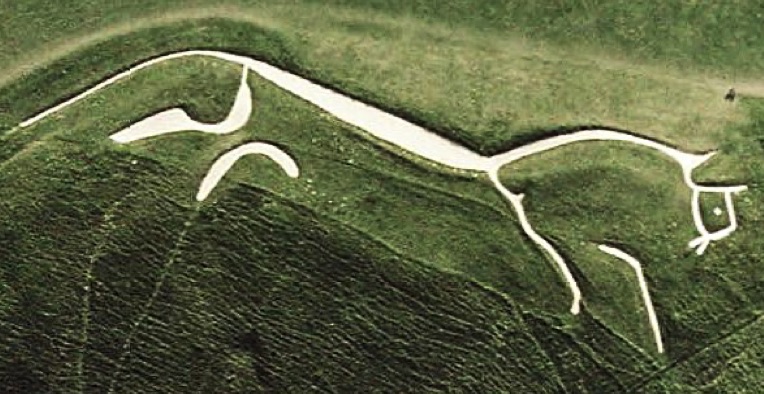
We woke to early morning rain, so after the brilliant weather yesterday, it lessened the blow of having to leave Falkirk. We headed south and crossed the border to England, bound for Carlisle again. The reason for returning to Carlisle was to visit Carlisle Castle, where the Border Regiment was based in the late 1800's, when Grandfather Isaac was a member of the Regiment. We had learned that there was a Border Regiment exhibit in the Military Museum at Carlisle Castle, and perhaps we could learn more about his time in the Regiment, and get some leads to follow up on his ancestry.
So, we worked our way into the centre of Carlisle, and found the carpark next to the Castle, which had plenty of space for campervans. The Castle itself looked rather humdrum from the outside, and nowhere near as spectacular as Stirling Castle. The inside was not much better. We found our way to the Museum, but the guy manning the entry desk was not able to provide much more information than we already knew. He said that if we knew Isaac's military number, that would help a lot in tracing his movements. So at least that's something for us to track down. We looked through the Museum but there was only a small exhibit relevant to the Border Regiment of the 1890's.
We went outside and looked around the (few) building inside the walls. I got Rita to take the photo below of me and the keep, when I realised that I would have been walking on ground walked on by my grandfather Isaac over 100 years ago when he was in the Border Regiment, before he left England to go to India, where he married Ellen (who had been born in Agra, India), fathered Phil (my dad), then moved the family to Australia, and the rest is history.
Fri 23 June - rain, leave Falkirk, Carlisle Castle, Border Regiment, Crossfels

After we finished exploring the Castle, we jumped back in the van and headed south to Penrith, where we would be staying again at Crossfels Campsite, so that we could catch up again with Ellen Pogson over the next couple of days.
It was windy overnight, but we felt safe and comfortable inside the van. Rita had an early morning Zoom seminar with colleagues in Australia, while I enjoyed a bit of a sleep-in. Later in the morning I followed the NRL game in which the Storm beat Manly 24-6. Around noon, we went for a walk across the neighbouring fields, staying close to the hedgerow boundaries and using the stiles provided to climb over fences (so different to Australia where walking over a farmer's property is a definite no-no), until we reached the George and Dragon pub that had been recommended to us by Craig at Crossfels (not sure why such pubs in the UK are called "George and Dragon", rather than "St George and the Fragon" - secularism?).
Sat 24 June - windy, Zoom, Storm, hedgerows, George&Dragon, cricket, SGP Doyle
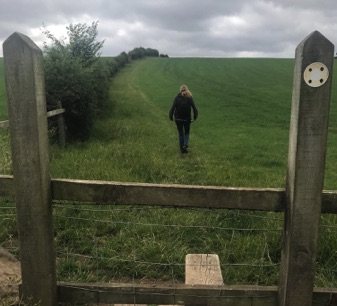
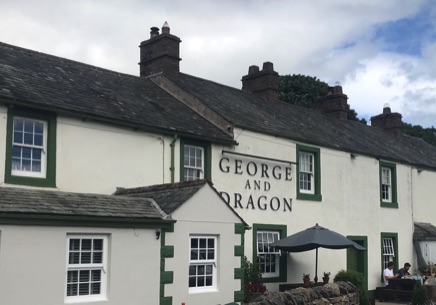
As we sat in the pub having a drink and some snacks, we were kept entertained by a blackbird who flittered across the top of the surrounding stone wall while singing to us. We also noted a statue that reminded us of good friend Doug Walter back home.

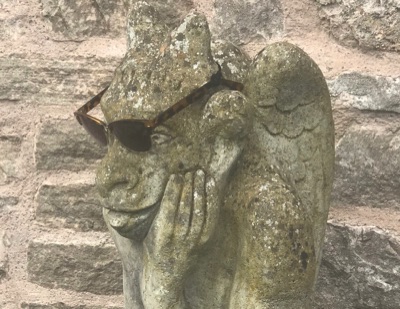
In mid-afternoon, we wandered back over the fields to Crossfels where we spent a very relaxed afternoon, during which I kept track of the Women's Ashes Test match. Both teams had got off to very good starts and at the end of the first innings Australia just led England 473 to 463. That evening, I followed the Speedway Grand Prix from Gorzow Poland, where Aussie Jason Doyle made the Final, but for the second meeting in a row was disqualified from the re-run after falling, but this time it was probably his fault.
As sunset approached, we watched the sheep in the Crossfels paddock behind our van, as they nibbled on their last feed for the day, with Craig's new house in the background.

The day started bleakly for me as I got up early to watch the Hawks play the Gold Coast Suns, where the Suns effectively won Infinity to Nothing (actually the score was 101-34, which wasn't as bad as the Eagles losing to the Swans 205 to 34, but it still felt pretty bad). Just another problem with a developing team of inexperienced players who don't know how to stop an opposition who get some momentum, even though the Hawks scored the first three goals of the game). In the late morning we headed down to Bowness on Lake Windemere, where Ellen Pogson was having adispaly of her pottery as part of an Art Fair as a lakeside property. We talked to her for quite a while, then wandered around the other exhibits. But the tour of the old house was the highlight, especially the view of Lake Windemere through the window panes in the house.
Sun 25 June - infinite Suns, Bowness, Lake Windemere, Ellen, rain, collapse

However, as we sat outside in the garden having a Devonshire Tea with Ellen, the rain moved in, and continued for the rest of the afternoon. So we left Ellen to allow her to go back to her exhibit, while we drove back to Crossfels. As I checked on the Women's Cricket score in the Ashes Test, I saw that Australia's batting had collapsed in the second innings, scoring just 257. This leaves England just needing to make 268 in their second inning's, with planty of time to get the runs (now that Women's Ashes games now run for 5 days, like the Men, rather than the 4-day Tests which have inevitably ended in draws over the past 10 years).
Today was a day of two parts, with the morning devoted to "work" and then some relaxation in the afternoon/evening. I spent the morning updating transactions for the "books" for our company TUTI for our accountant, so that he could prepare our annual tax returns, while Rita kept working on her thesis for her Music Therapy course. I also booked our ticket for the return journey to France, where we would be taking the Shuttle Train with the van to Calais, rather than going by ferry. I checked in with the Women's Cricket in the afternoon, and saw that England had collapsed even more than the Aussies, getting only 178 of the required 268 before being dismissed (perhaps it was a deteriorating wicket). This puts the Aussies in a prime position to retain the Ashes, over the course of the remaining 20/20 and one-day games.
As i was pottering around outside, Craig came by on his usual afternoon visit, and we got talking about backgrounds, where we both disciovered that the other was an engineer - he a water engineer and me a transport engineer. We talked for quite a while about common interests.
In the evening we went to have dinner with Ellen and her husband Matt, who live in the nearby town of Bampton. She advised us that we should park in a nearby town, and she would collect us in her car, because the roads leading to her house were very narrow. Given our experiences in the south of England with narrow roads, we readily agreed to her suggestion. So we parked in the parking area of a pub in Askham, and she then drove us to her house. She was right about the narrowness of the roads!
Before dinner, she suggested we go for a walk in the surrounding forest and fields, and on leaving her house we found this van in front of the house next door. Has my son had a change of occupation and location?
Mon 26 June - TUTI books, Rita thesis, booking, Ashes, Craig, Ellen&Matt, Gels

We then entered a forest valley with an enchanting stream flowing through the middle. A nice place to relax on a hot day, which England seems to be having more of.
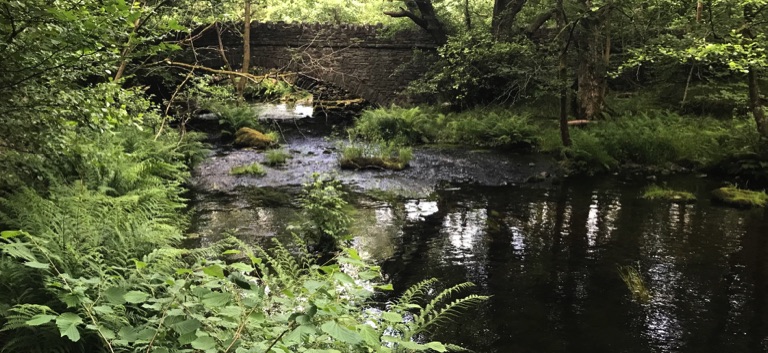
We then continued into a more open area which, like the mountains in Scotland, were covered in fields of bracken.

After the walk, with an appetite ready for dinner. Matt was the chef for the evening and did a great job, accompanied by a few bottles of nice wine. As midnight, approached, we thought it might be time to go home, so Ellen bundled us into her caar and drove us to Askham. I was glad she was driving, because along the way she spotted a hedgehog in the middle of the road, and dutifully slowed to allow it to get out of the way. Then it was home to Crossfels for a good nights sleep.
We slept in a little after last night, and awoke to a rainy landscape. Rita was feeling a little bit crook, so she slept for a little longer. After preparing the van, and taking advantage of the van service utilities at Crossfels, we were on the road at noon. This time we intended to head down the eastern side of England, and planned to stay tonight around Cambridge, where Rita and I were attending a conference on the fateful day of September 9 2001. As we crossed from the west to the east side of England, the scenery was at times barren, yet strangely beautiful. But things were about to change as we encountered long traffic delays on A66 due to a crash. We detoured off A66 and ran for a while along narrow country roads until we rejoined A66 and had a good run until Darlington, where it all came to a grinding halt once more. So we pulled off again and stopped at a pub parking lot while we considered our options. By now we had abandoned any hope of getting to Cambridge tonight, but in looking at our campervan apps, we spotted a pub with overnoight camping not too far off out intended path. So we headed for there and soon arrived at another George & Dragon pub, in the town of Whitley. We enquired inside and they said we could park the night there. So we decided to stay there, and then went inside for a drink and it was so nice, we stayed for dinner. A truly homely pub atmosphere!
Tues 27 June - rainy, leave at noon, A66 delays, George&Dragon, Whitley locks

After we finished dinner, we decided to go for a little walk in the area, and asked the staff about any interesting sites within walking distance. They told us that we were actually near a canal with a big set of locks at Whitley. So we headed in that direction, and before too long found outselves at the locks. There was a mixture of narrowboats and barges moored nearby, so this was obviously part of the canal system that was accessible to larger boats.
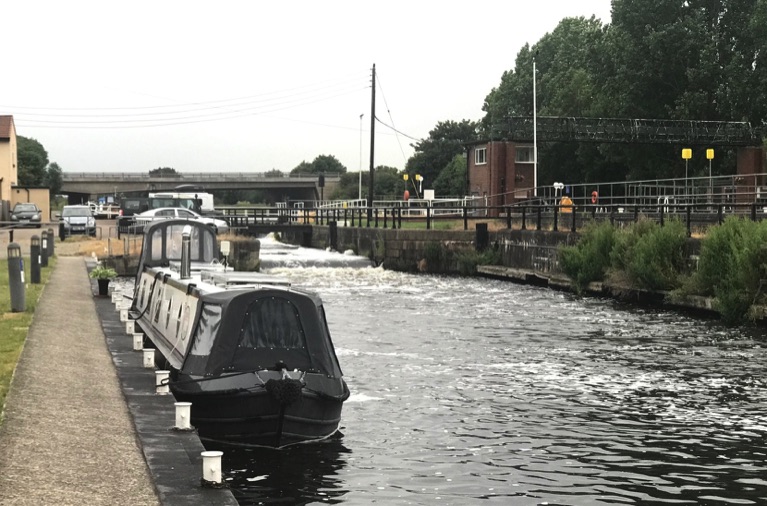
It was then back to the van at the George & Dragon, where we settled down for a good night's sleep before what would be our last day in England on this trip.
After a 1030h departure from the George & Dragon in Whitley, we followed the M2, M25 and M20 motorways to Dover. Unlike yesterday, there were no incidents and traffic flowed smoothly. We had plenty of time before our scheduled departure on the Shuttle this afternoon, so we parked the van and headed for the cliffs overlooking Dover. The first thing we saw were the docks at Dover where trucks were lining up to board the ferries to France. Luckily there were no strikes or other delays, and the queues of trucks were not excessive.
Wed 28 June - Dover, cliffs, Folkestone, exit 11a, delay, shuttle, Calais, Le Gravelot

We kept walking along the headlands above the docks and soon entered a grassed area, with a view of the White Cliffs of Dover (naturally, I couldn't stop singing a certain song as we walked along - and I bet you also now have that song playing in your head - sorry!).
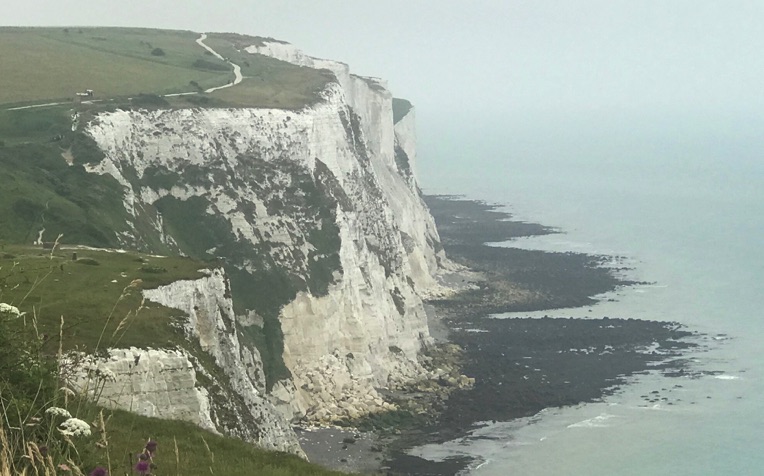
We could have continued walking to get a better view of the cliffs, but we knew that every minute we continued walking meant an extra minute to walk back, and we definitely didn't want to miss the Shuttle. So we turned around, had a quick cool drink at the cafe, and then headed back to the van. We then continued on the M20 to nearby Folkestone, from where the Shuttle departs. Google Maps suggested that we leave the M20 at Exit 11a, but as we drove along, we saw Exit 11 followed by Exit 12, but no Exit 11a in between. So we did a u-turn at the next interchange and headed back and found Exit 11a, which was only accessible when travelling in that direction (would be nice if Google Maps had told us that!). This exit led us directly to a large carpark where many cars and vans were waiting for the Shuttle. We checked the large screen in the carpark but saw no information for our departure. So I walked inside the terminal (to buy our duty-free Scotch) and checked with the information counter about our departure, and found that our train had been delayed for at least an hour. We were advised to just keep checking the departures screen. As the carpark gradually emptied, we were starting to worry just a little bit, but eventually our train departure information appeared and we left the carpark with many others to form queues for departure.

We noticed that the four queues held vehicles with different lengths (e.g. cars, vans, campervans, cars with caravans). when it came time to move towards the train, the guys controlling the departure of vehicles selected vehicles from each queue in a systemmatic fashion. We then moved in procession through the marshalling area. As we went, we saw the famous Folkestone White Horse carved into the limestone hillside. I had heard of this feature, and thought it must have been a landmark created by ancient peoples in old England. But a little bit of Googling later found that it was only created in the late 20th century on completion of the Shuttle Terminal!

When we arrived at the train platform, we drove onto the back of the train through a side entrance, and then continued to drive forward through the train until we approached the end of the stationery queue ahead. An attendant then closed the door at the front of our carriage, added another vehicle or two behind us and then closed the back door (and continued that process as they walked towards the rear of the train). We now realised that the earlier selection of vehicles from the four queues was done to create "virtual groups" of vehicles that would nicely fit within the length of one carriage on the train.
Within 10 to 15 minutes the train pulled away from the station and accelerated to cruising speed. We couldn't tell how fast we were moving, because there were no windows to look out of the train as we sped under the water towards France. But within about 25 minutes we started to slow and soon we were driving off the train in Calais, where we would stay the night. We found a camping car site in Le Gravelot, and while it was not very fancy it was able to receive arrivals at any time of day, which was very useful for new arrivals on the Shuttle. We settled down for a good night's sleep in Vanumbra.
We woke to overcast but dry weather. So after breakfast, we left the campsite and drove down to the beach at Calais. The thing that surprised me most was the wide, very sandy beachfront, just like a beach back in Australia, and very different from the pebbly beaches we found in the UK. Predictably, Rita was quick to discard her shoes and walk down to the water, just as a ferry was departing to go to Dover.
Thurs 29 June - beach, rain, cars, Villers-Bretonneux, school, Corbie overnight
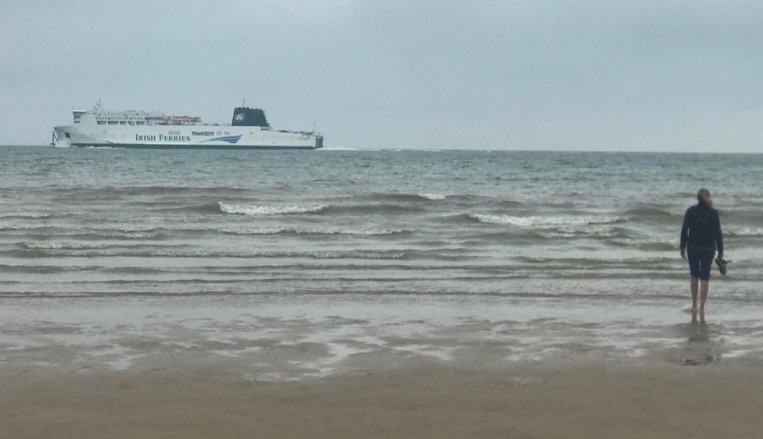
Equally as predictable, once Rita could feel the beach sand on her bare feet, she started doing Karate Katas, as she had done for many years on the beaches near Beziers before (and sometimes after) she came to Australia.
But after a short time, the rain arrived and we departed the beach. We had intended today to visit good friends Dede and Francoises up near the Belgium border, but a couple of days ago we learned that Dede's mum had died and the funeral was being held today. So we opted to catch up with them later, and headed south instead.
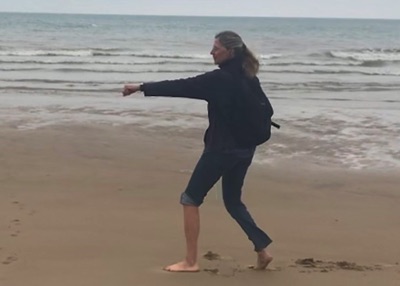
Since we were up in the north-west of France, I decided to go to Villers-Bretonneux and show Rita this town with a very strong link to Australia. As we drove down the A16 motorway, we kept getting passed by all sorts of sports and vintage cars. At first, I thought they were just interesting to look at, but after the 50th one had passed us, I realised that something was afoot. And when we pulled into an Aire along the way, we saw that we were joining many of the cars that had passed us. And we soon found out, they were all on their way to the annual car rally at the Le Mans motor racing circuit. The collection of cars at the Aire was a sight to behold, and many a car enthusiast couldn't believe their luck as a proliferation of cameras made an appearance.

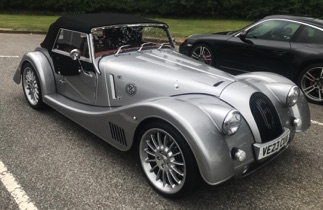
After a couple more hours, we made our way into Villers-Bretonneux. At one of the very first shops we saw, the Australian flag in the window gave us an indication of the strong French-Australian linkages in this town.
But what we were really looking for was the primary school building, where a couple of plaques on the wall (in French and English) gave an idea of the story behind this linkage which persists to this day, more than 100 years later.
The sign inside the schoolyard "Never Forget Australia" also conveyed the message.


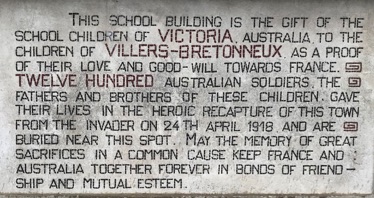
We entered the school building and went up to the second floor, where a museum had been created honouring the contributuions of Australian, NZ and Canadian forces in liberating Villers-Bretonneux from German occupation on 24th April 1918. The museum contains many artifacts of that time, most donated by family and friends of soldiers who lost their lives during the liberation. One little item that caught our attention was a children's book "The Promise" written by Derek Guille, a colleague who worked as a broadcaster at ABC radio in Melbourne at the same time as I was doing a weekly appearance on the NightTime show talking about transport planning. Amazing how paths can cross in such different ways.
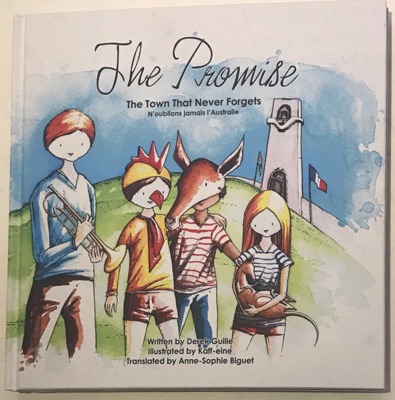
As we were talking to the receptionist at the museum, we were introduced to a guy who was a teacher in the primary school. We started talking, but he had to excuse himself as he was due to start teaching a class. But he said we should go down to the schoolrooms after we finished at the museum, and he would be happy to talk with us, and answer any questions we had. Well, we must have spent more time in the museum than expected, because when we went downstairs afterwards, the doors to the school were locked. So we were resolved to leaving without meeting him properly. But as we were about to leave, the receptionist appeared on her way out, and said that he had just started teaching his next class, and if we were to just knock on the outside window of the classroom, he would open it and say hello. So after she showed us which window to knock on, we did so, and a short while later he opened the window and said hello. He then introduced us to his class of about 25 students as 'two Australians who have come to say hello". He then said "Ready, class?", and all 25 students burst into song singing Waltzing Matilda!! To say we were shocked would be an understatement; we just stood there smiling back at all the 25 faces smiling at us. It was a very emotional moment for me (I have tears in my eyes as I write this). I had heard of the Villers-Bretonneux story, but that was the first time I had every really experienced it. And to think that this teacher teaches the words and music of Waltzing Matilda to a new class of students every year and so continues the history. It was a moment we shall never forget.
Now that we were in Villers-Bretonneux, we decided to go have a look at the Australian War Graves Memorial and, if possible, the new Monash War Museum. I had been to the War Graves once before and while I am not a great fan of War Memorials, this one stopped me in my tracks and made me think. It did it again today, but in a different way. So we drove a few kilometres out of town and found the sites. Once again, the sight of the multitude of graves, especially those dedicated to An Unknown Soldier, made us stop and think. But last time I was here, the weather was fine and the sky was blue, and I was shocked to think that such atrocities could happen in such a beautiful countryside. Today, as we started to walk among the graves, it started to rain and then became quite drenching, and we had neither umbrellas or raincoats (having left them in the van). But as we got wetter, it made us think of the soldiers in 2018 trudging through the rain and the mud, feeling tired to the bone and begin fired upon by enemy troops. It put our little inconvenience into perspective.

As the rain continued, we decided to seek some shelter under the eaves of the War Memorial Tower at the top of the hill. And it was here that a mystery was solved. While we had hoped to visit the Monash War Museum, we couldn't find it! But as we walked to the easterm side of the tower (the rain was coming from the west), we found the Monash Museum tucked away behind the tower in a very inconspicuous fashion. A brilliant architectural design, which combines the two memorials, without having the new structure overshadow the older structure. Unfortunately, the Monash Museum was closed for the day, but at least we now know where it is for the next visit to Villers-Bretonneux.
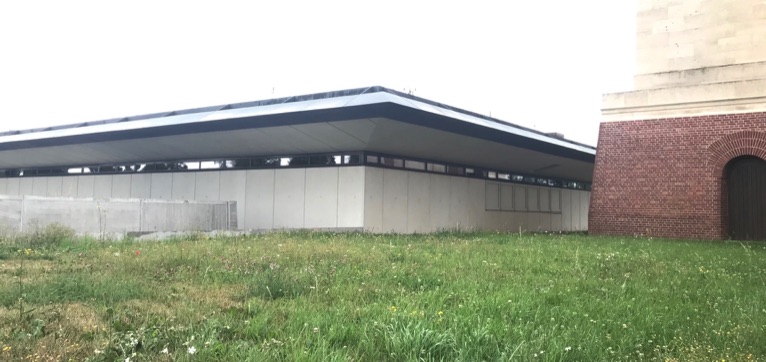
So, after a hectic, emotional day, all we had to do now was find a place to stay for the night. Once again, the CamperContact app came to the rescue and we found a great little municipal campsite in nearby Corbie (another battle site), which also serves as a port for recreational boaters on the River Somme (the serviced mooring is on the left and the campsite is behind the hedges on the right of the photo below). Since we want, at some stage, to cruise the Somme in Kanumbra, it was good that we could test the facilities from the comfort of Vanumbra overnight.

Given that this was the last day of our motorhome trip, we took our time rising and breakfasting, and then took a short walk along the Somme, before eventually departing Corbie at 1030h. It was an uneventful drive, and along the way we stopped at an Aire for lunch, to read emails etc and to check the Ashes cricket scores. While we were at the Aire I noticed some Electric Vehicle "fuel pumps" where, unusually, the price was displayed. A few quick calcs showed that it was about the same price per km as diesel (in France), but much more expensive that if you charge the EV using electricity generated by your own solar panals at home (about 6 cents per kWh). I also had a cute bug land on my thumb (that's how exciting today was, when that warrants a photo!)
Fri 30 June - 1030h start, aire stop, bug, EV fuel price, home to Auxonne


After we recovered from the excitement of the bug, we continued our journey and reached St Jean de Losne in mid-afternoon, where we transferred our luggage from the van to the Scenic, then left the van in the secure car park and drove the Scenic to Auxonne. After shifting everything from the Scenic to the boat, it was then time to relax with a drink and then dinner on the rear deck, while we acclimatised once again to life aboard in Port Royal.

Perhaps the reason for my confusion was that there are several "white horses" in the UK which are much older, such as the Uffington White Horse (below) which was created somewhere between 1200BC and 500BC!
